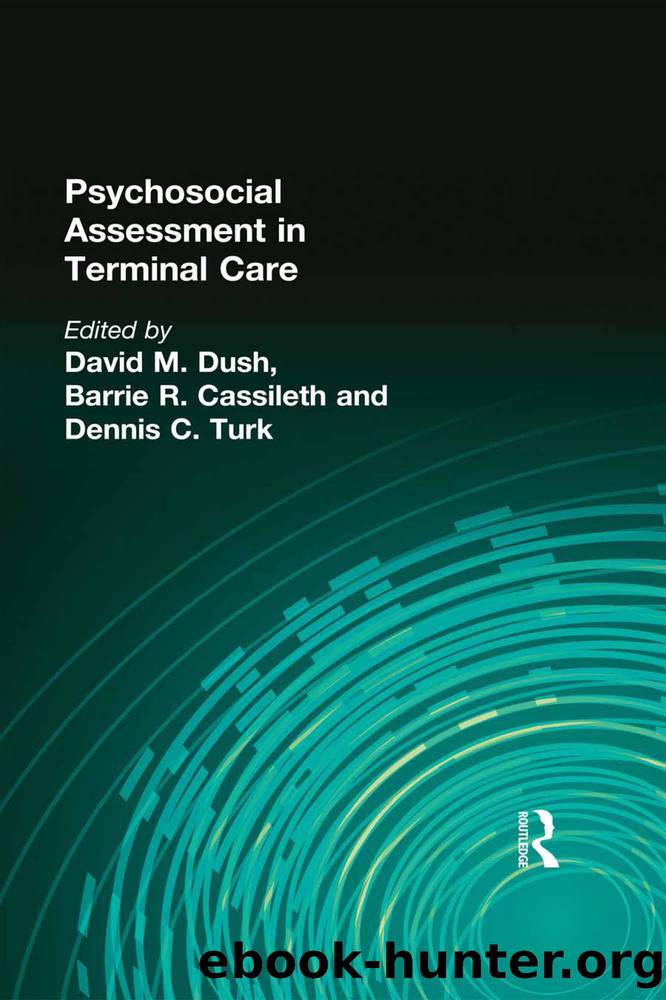Psychosocial Assessment in Terminal Care by unknow

Author:unknow
Language: eng
Format: epub
Publisher: Taylor & Francis Group
Published: 2022-08-15T00:00:00+00:00
Assessment of Pain and Anxiety
Assessment of Infants
The investigation of pain in infants has focused primarily on infant cries. Wasz-Hockert, Lind, Vuorenkoski, Partanen, and Valanne (1968) examined the acoustical properties of infant cries and found that pain cries were less likely than other cries to have rising/falling characteristics and were more likely to last longer. In two studies of tape recordings of infants (Wolfe, 1969; Zeskind, Sale, Maio, Huntington, & Weiseman, 1985), the initial portion of cries was found to be the segment which elicited adult attention and presumably communicated a heightened level of infant arousal. In a review of studies analyzing the cries of human infants and primates, Levine and Gordon (1982) found pain cries to be unique and unlike the cries of hunger and other sensations.
In addition to cries, behavioral and physiological assessments have also been made in infants. Craig, McMahon, Morison, and Zaskow (1984) examined developmental changes in pain expression provoked by routine immunization injections in infants under two years of age. Infants less than 12 months of age responded to injections in an apparently random, diffuse manner, whereas infants 12-24 months of age displayed more anticipatory distress, descriptive language, and goal directed movement. Unfortunately, the relationship between infantsâ cries and their behavior was not assessed. Palmar sweating during heel pricks was found in newborns over 37 weeks gestation (Harper & Rutter, 1982). While it may be assumed that this physiological parameter indicated pain in the neonates, no other measures were used (e.g., infant cries) to corroborate this belief.
In summary, infants demonstrate their distress associated with pain through changes in the nature of their cries. As they approach toddlerhood, they are able to contribute more demonstrable language and body movements to indicate pain. Physiological indices of pain in infants have not yet been validated against cries or pain-associated behaviors. Other such behaviors of longer duration, such as sleep or feeding disturbances, also warrant investigation for a fuller understanding of the nature of pain in infants.
Download
This site does not store any files on its server. We only index and link to content provided by other sites. Please contact the content providers to delete copyright contents if any and email us, we'll remove relevant links or contents immediately.
Unwinding Anxiety by Judson Brewer(72698)
The Art of Coaching by Elena Aguilar(52866)
The Fast Metabolism Diet Cookbook by Haylie Pomroy(21037)
Rewire Your Anxious Brain by Catherine M. Pittman(18513)
Healthy Aging For Dummies by Brent Agin & Sharon Perkins RN(16983)
Talking to Strangers by Malcolm Gladwell(13168)
The Art of Thinking Clearly by Rolf Dobelli(10166)
Crazy Rich Asians by Kevin Kwan(9143)
Mindhunter: Inside the FBI's Elite Serial Crime Unit by John E. Douglas & Mark Olshaker(9140)
The Compound Effect by Darren Hardy(8765)
Tools of Titans by Timothy Ferriss(8176)
Periodization Training for Sports by Tudor Bompa(8126)
Becoming Supernatural by Dr. Joe Dispenza(8069)
Wonder by R. J. Palacio(7926)
Crystal Healing for Women by Mariah K. Lyons(7840)
Bodyweight Strength Training by Jay Cardiello(7821)
Therapeutic Modalities for Musculoskeletal Injuries, 4E by Craig R. Denegar & Ethan Saliba & Susan Saliba(7675)
Change Your Questions, Change Your Life by Marilee Adams(7593)
Should I Stay or Should I Go? by Ramani Durvasula(7535)
